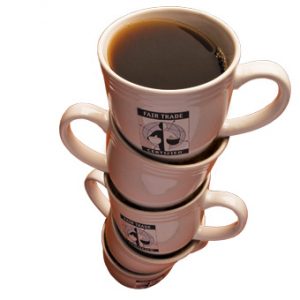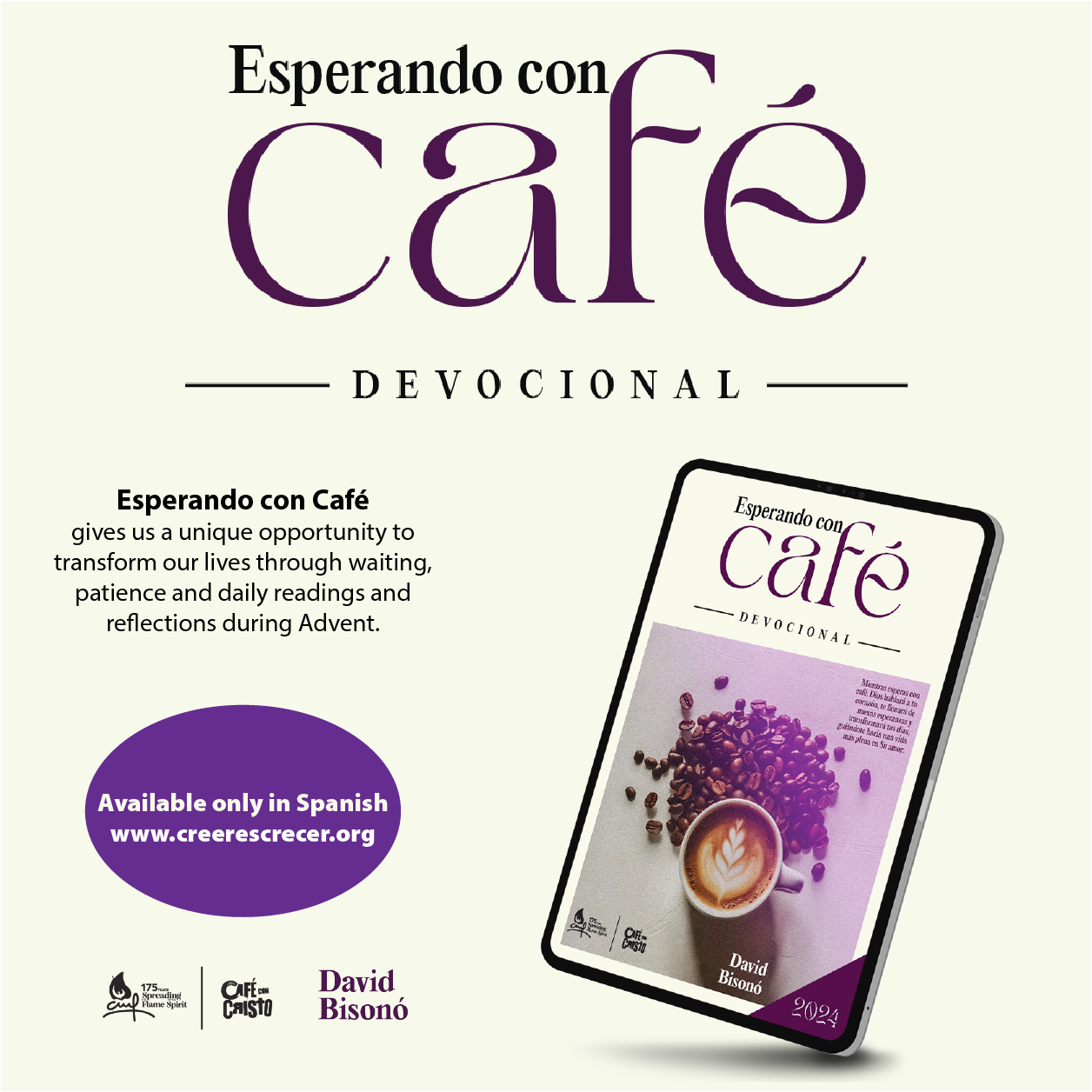 Can fair trade grow beyond just coffee?
Can fair trade grow beyond just coffee?
Sunday Mass has ended at St. Mary of Sorrows Catholic Church in Fairfax, Virginia, and parishioners are filing out. Deb Caskey stands in waiting, a smile on her face, a mission in her soul, and a table filled with coffee and chocolate at her side.
It’s “Fair Trade Sunday” at St. Mary’s, and Caskey is in overdrive.
There’s a ripple effect to the day’s purchases, Caskey explains. The coffee comes from farmer cooperatives in Africa and Latin America, while the chocolate comes from Ghana. The purchase of a fair trade product today, Caskey reminds her fellow parishioners, helps create life-changing opportunities for poor producers and their communities in these nations. Fair trade allows front-line workers to earn a “fair” wage by cutting out the usual mechanisms of trade that divert income from the producers.
“The Holy Spirit churned in me to get more connected,” Caskey says of the fair trade sales she runs at St. Mary’s at least six times each year. “You feel your work helps build better lives.”
Caskey’s journey into the fair trade world has been one of reflection and purpose. In November 2008 she and her husband traveled to Costa Rica, one of Central America’s purported “wealthier” nations. “But I only saw extreme poverty over and over,” she says. “That trip opened my eyes and made me even more committed to fair trade.”
Seeing poverty firsthand, she says, opened her eyes to ways in which she could be a more responsible consumer at home. She soon began evangelizing as a Catholic Relief Services fair trade ambassador for the Diocese of Arlington, Virginia as well.
“Catholic social teaching tells us the life and dignity of the human being is foremost. We are all called to serve and help, and fair trade is one way to make that happen,” Caskey says.
Though few question the goal of fair trade–lifting people out of poverty–the movement’s long-term viability stands on wobbly legs even amidst year-over-year growth. As the fair trade movement seeks mainstream acceptance and broader social and economic justice, many wonder if it can become anything more than a niche market.
Economics with altruism
Thanks to fair trade, Fredis Paez, a worker on the El Antojo banana farm in Colombia, and his wife were able to open a local store. This once-unimaginable act for the laborer was made possible by an 80 percent rise in income along with a microloan. Paez’s story is typical of fair trade programs, which traditionally have involved agricultural products.
Fair trade organizations approach development as a holistic process, not just a pricing mechanism. They cultivate direct relationships with workers in developing countries, shortening a product’s journey from the producer’s hands to the store shelf–or church sale–and eliminating the various “middlemen” found in conventional trading. More of a product’s purchase price reaches front-line workers, allowing people like Paez to see their incomes rise.
Often, but not always, fair trade products carry an above-market price. Consumers are willing to pay more for the knowledge that proceeds are channeled back into the farmers’ hands and communities, creating broader social change.
As core principles of fair trade, worker cooperatives receive a guaranteed floor price for their products, enjoy safe working conditions and living wages, and negotiate direct, long-term contracts with international buyers.
Cooperatives also democratically decide how to invest the trade premiums–a sum of money paid on top of the agreed-upon fair trade price to fund academic, social, or health development projects. At El Antojo banana farm, for instance, the premiums funded the microloan program that helped Paez start his own store. Increased income allows families to meet basic needs, keep children in school, and remain on their land, thereby improving quality of life and allowing them to take greater control of their futures.
The fair trade movement was largely driven by the Mennonite Central Committee in the United States after World War II, but 15 years ago Catholic Relief Services (CRS), noting fair trade’s alignment with Catholic social teaching, created an office dedicated to the issue. “Fair trade [is] one avenue to help Catholics live their lives in solidarity and continue the drive for the common good and human dignity,” says Jackie DeCarlo, CRS’s senior program advisor for economic justice.{C}
Not just church sales
Church folks aren’t the only ones in the fair trade marketplace these days. In recent years, fair trade momentum has accelerated. Fair trade-certified coffee constituted little more than 2 million pounds of U.S. imports in 1999; a decade later the United States imported nearly 110 million pounds.
Fair trade has expanded from its coffee origins to include other goods as well: fruit, tea, cocoa, sugar, cotton, jewelry, sports balls, wine, and flowers. In late 2010, TransFair USA, the nation’s leading independent, third-party certifier of fair trade products, welcomed fair trade apparel. The garments, made with Indian and Peruvian cotton, extend fair trade’s agricultural objectives into the manufacturing world, a significant milestone for the movement.
Thanks to emerging relationships with leading retailers such as Whole Foods, Costco, Walmart, and a host of socially responsible small businesses, U.S. consumers today can choose from more than 6,000 products sourced from 58 nations. In 2009 alone, TransFair USA-certified goods generated $1.2 billion in U.S. sales, a 7 percent rise over 2008, distributing more than $14 million to 865 worker organizations to fund various community development projects, including schools and hospitals.
“When people know the back story, fair trade becomes far more intriguing,” TransFair USA spokesperson Stacy Wagner says.
The movement’s momentum shows no signs of slowing, particularly as socially conscious consumers surface as a growing and vocal contingent and businesses jump on board.
In 2009 Starbucks purchased 39 million pounds of fair trade coffee, doubled from 2008. Dunkin’ Donuts, which had long been using fair trade espresso beans but not marketing its alliance, began sharing its fair trade story on cups, igniting consumer awareness. Ice cream giant Ben and Jerry’s, an enthusiastic fair trade advocate, recently announced that 100 percent of its products, from its Cherry Garcia dark chocolate to its Chunky Monkey walnuts, would be certified fair trade by 2013, a decision that will drive conversions with its producers and suppliers.
Despite positive growth, fair trade products still only represent a fraction of available offerings to U.S. consumers. Experts say that fair trade must maintain its push into the mainstream market, collecting ethical consumers and working with brands to educate consumers. “But this all takes time, innovative brands, and retailers,” Wagner says. The certification of fair trade coffee has only been aound for 11 years, tea for seven years. “The longer these categories are in existence, the better.”
Small is beautiful
In south Florida Jorge Malo runs Fasanis, an upstart Internet business selling handmade soaps. In early 2009 Malo began seeking a way to further distinguish his products and landed upon a fair trade cooperative in Zimbabwe that created handmade paper. Their products, Malo thought, could serve as the packaging for Fasanis’ soaps, sharing both the story of his company and fair trade, a movement in which Malo saw virtuous, worthy components.
“My wife and I went on our honeymoon to Zimbabwe, so we’ve seen the struggles of these people,” Malo says. “We thought this partnership could be a win-win for everyone.”
The entrepreneurial Malo quickly learned that fair trade had its limits. First, a lack of financing in fair trade communities limited their growth in an independent, sustainable manner. Second, the communities had little practical knowledge of the Western marketing and business process. And finally, communities struggled to increase their productivity to a level at which greater volume could create a more competitive price.
“The community on one side and the buyers on the other don’t necessarily work together,” Malo says. “It’s difficult for us to continue paying for this premium product and then expect the end consumers to absorb the costs as well. We’ll keep trying, but I’m seeing some real limitations.”
Furthermore, Malo and many others contend, a compelling story alone is not enough in the American “bang-for-the-buck” marketplace, which resists the higher cost for an unseen benefit half a world away.
Then, of course, there is the argument from free trade proponents that fair trade disrupts the very economies it vies to assist. Some critics forecast that fair trade’s ignorance of market rates could ratchet up the price of the world’s food supply, thereby demanding a larger portion of household income from the workers the movement aims to support. Detractors say free, open trade will better translate into increased national welfare, along with better prices for consumers.
“The fair trade movement has hung its marketing plan on the stories of the people that fair trade helps, but price and quality concerns generally win out in the end,” says Christopher Kent, a futurist with Foresight Alliance, a Washington, D.C.-based consulting firm specializing in global consumer issues.
In the midst of a recession, economic pressures threaten to further thwart fair trade’s growth, particularly among lower and middle-class consumers, who are unlikely to embrace fair trade’s premium prices. TransFair USA acknowledges that ethical buying rises in proportion to discretionary income. As a result, fair trade’s momentum relies on those with the means to be premium buyers, a minority of the American population.
“As a culture, we’re very interested in getting the best deal, and that’s a hurdle for fair trade to climb in any economic climate,” DeCarlo says. Still, DeCarlo sees an opportunity with the recession for reflection to prompt solidarity, spurring individuals and families to assess their budgets. “Consumers can consider consumption and how they can be more conscious,” she says. “How can we use our income well and form the right relationships so that our dollar has more impact?”
Brand confusion
Working with TransFair USA, San Francisco-based marketer Mortar Agency took a group of self-identified ethical consumers to Whole Foods and asked the shoppers to pull fair trade products. The result: confusion.
“There’s been a lot of time devoted to talking about the farmers who are thousands of miles away, but there was really no push to connect directly with the consumer, and that’s been a limiting factor,” Mortar’s Mark Williams says. If fair trade is to accomplish its ambitious objectives, Williams argues, the fair trade community at large needs to concentrate on the consumer experience.
“These are the people who will spread the word about fair trade, but even they were a bit in the dark. This has to change, allowing the consumer to discern what’s real and what’s marketing jargon,” Williams says.
Recognition of the fair trade label in the United States hovers near 30 percent. Even fair trade ambassador Caskey, however, worries that fair trade might become more slogan than substance as it goes mainstream.
“The more I learn the more I want to question: Are the farmers getting the money? Are they being treated fairly?” Caskey says. “Hopefully we’re helping farmers stay afloat and providing the dignity of work that is so central to the human existence. That’s the root of fair trade and, hopefully where it will remain.”
While aggressive efforts from TransFair USA and other credible organizations are being made to unify fair trade messaging, the term’s adoption by corporate marketing mavens threatens to derail the progress. “In trying to enter the mainstream,” DeCarlo contends, “companies that have embraced the certification might not always embrace fair trade standards, while consumers have likewise struggled to understand the standards reflected through the label.”
With ethical consumerism on the rise, fair trade can be seen as a corporate ploy into one’s wallet. In 2009 a study commissioned by TransFair USA found that 93 percent of so-called ethical consumers reported a positive perception of the host brand when the fair trade-certified label was present. Such a high number offers fuel to corporations seeking inroads to a growing demographic willing to pay above-market prices for the promises-albeit unseen, in the vast majority of cases-of fair trade.
As an example, Wagner of TransFair USA cites Starbucks, which only reluctantly entered the fair trade movement in 2000. Though the Seattle-based coffee giant now purchases more fair trade coffee than anyone, fair trade-certified blends represent a fraction of the company’s total volume. Most of its coffee–81 percent in 2009–is certified by another process called C.A.F.E. (Coffee and Farmer Equity) Practices. Even so, Starbucks enjoys the benefit from aligning itself with the fair trade movement.
“In this way, perception becomes reality,” DeCarlo says. She believes the large-scale corporate outlook runs counter to fair trade’s small-scale production model.
Insincerity from retailers, if even in perception alone, could sidetrack the movement.
Fast forwarding fair trade
With room to grow in both market penetration and products, the fair trade system can benefit from consistent scrutiny and a holistic outlook.
“Catholic Relief Services is clear that fair trade is but one part of people leading more fair and full lives, but we shouldn’t overstate it,” DeCarlo says. “Sound governance and infrastructure are of central importance.”
In a decade, fair trade skeptic Kent believes, fair trade will have increased its market share a few points but will flatline thereafter.
“In spite of the evangelicalism of the fair trade movement, there’s nothing to indicate it will ever be more than a niche market,” Kent says. “It’s not for lack of effort, but simply that the entire Western mercantile system works against it.”
Fair trade products, as Malo’s story shows, are limited to a specific scale simply by the way cooperatives produce their goods. “There’s only so much these workers can produce in a year,” Kent says.
Ultimately, fair trade’s mainstream success resides in a balance between capitalist business objectives and activist outreach tied to the ethical concerns that inspired its creation. Such is the only way, its loudest proponents argue, that fair trade can ensure a better, more ethical, and human future.
This article appeared in the November 2010 issue of U.S. Catholic (Vol. 75, No. 11, pages 12-16).
Image: Tom Wright













Add comment